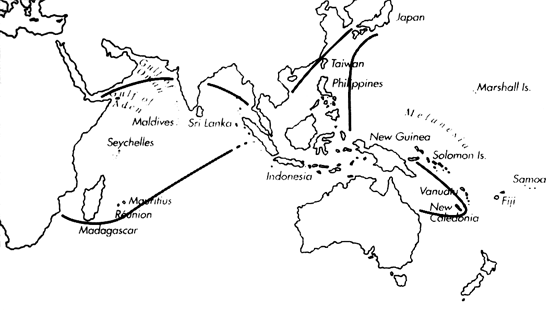Range: E. Africa to W. Thailand and Indonesia; Japan to Philippines; Papua New Guinea, New Caledonia, and Queensland.
Description: Small to moderately small, light to moderately light. Last whorl usually conical to broadly conical; outline variably convex adapically, straight (right side) or concave (left side) below. Shoulder angulate to sharply angulate. Spire of moderate height to high, slightly stepped; outline slightly to deeply concave. Larval shell of 3.0-3.5 whorls, maximum diameter 0.8- 1.0 mm. First 3-6 postnuclear whorls tuberculate. Teleoconch sutural ramps flat to concave, without spiral sculpture. Last whorl with punctuate spiral grooves below centre and variably broad ribbons between.
| Shell Morphometry | ||
|---|---|---|
| L | 18-29 mm | |
| RW | 0.04-0.11 g/mm | |
| RD | 0.62-0.74 | |
| PMD | 0.83-0.95 | |
| RSH | 0.16-0.30 | |
Colour variable, primarily brownish orange, red, or olive. Last whorl with a variably broad, axially maculated white spiral band below centre, mostly edged by darker flecks or bands and usually with a variable number of dotted brown spiral lines. Occasionally conspicuous solid brown spiral lines from base to shoulder. Base and columella often tinged with violet. Larval whorls pink to violet; early postnuclear sutural ramps of the same colour and immaculate. Following ramps white, variably marked with brown radial blotches and marginal spots; shoulder edge regularly ornamented with brown spots. Aperture translucent.
Periostracum yellowish grey, thin, translucent, smooth, except for oblique ridges on sutural ramps.
Dorsum of foot pink dotted with black and white, brighter pink at ends. Sole of foot pink, brighter at ends. Rostrum and tentacles pink. Siphon orangish pink spotted with white, spots larger proximally (Chaberman, pers. comm., 1981)(Pl. 76, Fig. 60).
Radular teeth lack barbs, bear a strong basal spur and have a slight waist at the centre (Azuma & Toki, 1970).
Habitat and Habits: In 35-240 m, in coral sand.
Discussion: C. otohimeae resembles C. articulatus, but it differs in its larger size (to 40 mm), often tuberculate shoulder, lower spire (RSH 0.12-0.20), and narrower last whorl (RD 0.59-0.64). It does not have a violet base, and the radular teeth also differ (Azuma & Toki, 1970). Juvenile specimens of C. lischkeanus from E. Africa (Pl. 52, Figs. 9, 10) may be very similar to C. articulatus, but can be distinguished by the presence of spiral grooves on sutural ramps and the absence of tuberculate whorls. C. hamamotoi has a generally broader last whorl (RD 0.70-0.79) and a generally lower spire (RSH 0.15-0.22); its early postnuclear sutural ramps have 1-2 spiral grooves, its larval shell is pale orange rather than pink to violet, its base consistently white, and its late sutural ramps are brownish red but not white. For comparison with C. dayriti, see the Discussion of that species. C. articulatus is very variable in shape, especially colouration and spire height, irrespective of locality. Specimens described as P. nadaensis from Japan (Pl. 52, Figs. 6, 7) falls within the range of variation observed in C. articulatus from Philippines and W. Thailand. C. lombei refers to a colour pattern variant of C. articulatus with an evenly reddish brown last whorl. The holotype of C. tosaensis (Pl. 52, Fig. 8) was collected dead and most probably represents a very large specimen of C. articulatus.

C. articulatus range map
This section contains verbatim reproductions of the accounts of 316 species of Conus from the Indo-Pacific region, from Manual of the Living Conidae, by Röckel, Korn and Kohn (1995). They are reproduced with the kind permission of the present publisher, Conchbooks.
All plates and figures referred to in the text are also in Röckel, Korn & Kohn, 1995. Manual of the Living Conidae Vol. 1: Indo-Pacific Region.
The range maps have been modified so that each species account has it own map, rather than one map that showed the ranges of several species in the original work. This was necessary because each species account is on a separate page on the website and not confined to the order of accounts in the book.